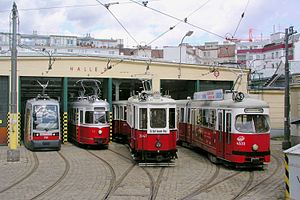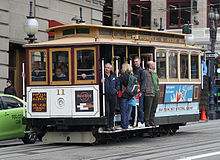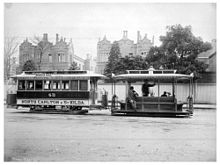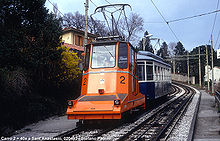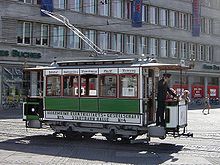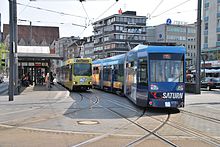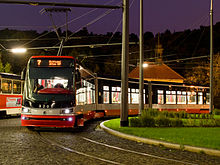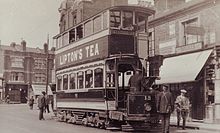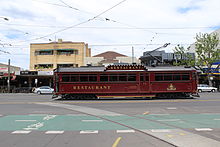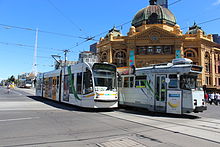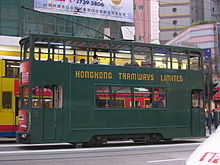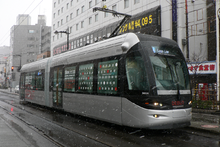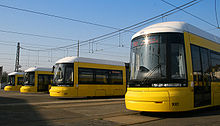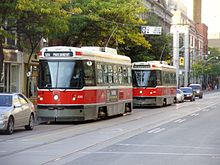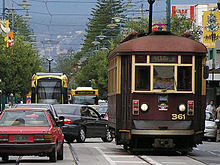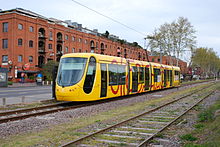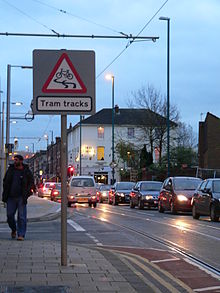
Tram
Did you know...
SOS Children volunteers helped choose articles and made other curriculum material Sponsor a child to make a real difference.
| Rail transport |
|---|
| Operations |
| Track |
| Maintenance |
| High-speed railways |
| Gauge |
| Stations |
| Trains |
| Locomotives |
| Rolling stock |
| Companies |
| History |
| Attractions |
| Terminology |
| By country |
| Accidents |
|
Modelling |
|
|
A tram (also known as a tramcar; a streetcar or street car; and a trolley, trolleycar, or trolley car) is a rail vehicle which runs on tracks along public urban streets (called street running), and also sometimes on separate rights of way. Trams powered by electricity, which were the most common type historically, were once called electric street railways. Trams also included horsecar railways which were widely used in urban areas before electrification.
Trams may also run between cities and/or towns (for example, interurbans, tram-train), and/or partially grade separated even in the cities ( light rail). Trams very occasionally also carry freight.
Tram vehicles are usually lighter and shorter than conventional trains and rapid transit trains. However, the differences between these modes of public transportation are often indistinct. Some trams (for instance tram-trains) may also run on ordinary railway tracks, a tramway may be upgraded to a light rail or a rapid transit line, two urban tramways may be united to an interurban, etc.
Most trams today use electrical power, usually fed by an overhead pantograph; in some cases by a sliding shoe on a third rail or trolley pole. If necessary, they may have several power systems. Another power source is diesel oil; a few trams use electricity in urban streets, and diesel in more rural environments. Steam, petrol (gasoline), gas and draft animals have historically been used as power sources. Horse and mule driven trams do still occur, mostly for the tourist trade. Certain types of cable car are also known as trams.
Tramways are now included in the wider term " light rail", which also includes segregated systems. Some systems have both segregated and street running sections, but are usually then referred to as trams, because it is the equipment for street running which tends to be the decisive factor. Vehicles on wholly segregated light rail systems are generally called "trains", although cases have been known of train equipment built for a segregated system being sold to new owners and becoming "trams".
Etymology and terminology
The terms tram and tramway are derived from the Scots word tram, referring respectively to a type of truck used in coal mines, and the tracks on which they ran. The word tram probably derived from Middle Flemish tram ("beam, handle of a barrow, bar, rung"), a North Sea Germanic word of unknown origin meaning the beam or shaft of a barrow or sledge, also the barrow itself. Tram-car is attested from 1873.
Although the terms tram and tramway have been adopted by many languages, they are not used universally in English; North Americans prefer streetcar, trolley, or trolleycar. The term streetcar is first recorded in 1840, and originally referred to horsecars drawn by draft horses. When electrification came, Americans began to speak of trolleycars or later, trolleys. These terms are believed to derive from the troller (possibly from the words traveler and roller), a four-wheeled device that was dragged along dual overhead wires by a cable that connected the troller to the top of the car and collected electrical power from the overhead wires.
The troller design frequently fell off the wires, and was soon replaced by the more reliable trolley pole. This newer device was fitted to the top of the car, and was spring-loaded in order to keep a small trolley wheel or alternately, a grooved lubricated "skate" mounted at the top of the pole, firmly in contact with the underside of the overhead wire. The terms trolley pole and trolley wheel both derive from the troller. Trams using trolley-pole current collection are normally powered through a single pole, with return current earthed through the steel wheels and rails. Modern trams often have an overhead pantograph mechanical linkage to connect to power, abandoning the trolley pole altogether.
In North America, trams are sometimes called trolleys, even though strictly this may be incorrect, and the term may even be applied to cable cars, or conduit cars that instead draw power from an underground supply. Conventional diesel tourist buses decorated to look like streetcars are sometimes called trolleys in the US ( tourist trolley). Furthering confusion, the term tram has instead been applied to open-sided, low-speed segmented vehicles on rubber tires generally used to ferry tourists short distances, for example on the Universal Studios backlot tour.
Over time, the term trolley has fallen into informal use, and may be applied loosely to a wide variety of different vehicle types. The word has taken on a historic or picturesque connotation, and is often associated with tourist or leisure travel. In North America, professional or formal documents generally use more precise alternative terms, such as streetcar or light rail vehicle (LRV).
Although the use of the term trolley for tram was not adopted in Europe, the term was later associated with the trolleybus, a rubber-tyred vehicle running on hard pavement, which draws its power from pairs of overhead wires. These electric buses, which use twin trolley poles (one for live current, one for return), are also called trackless trolleys (particularly in the northeastern US), or sometimes simply trolleys (in the UK, as well as in Seattle and Vancouver).
History
Horse-drawn
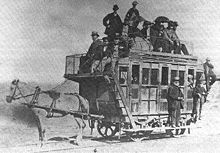
The very first tram was on the Swansea and Mumbles Railway in south Wales, UK; it was horse-drawn at first, and later moved by steam and electric power. The Mumbles Railway Act was passed by the British Parliament in 1804, and the first passenger railway (similar to streetcars in the US some 30 years later) started operating in 1807.
The first streetcars, also known as horsecars in North America, were built in the United States and developed from city stagecoach lines and omnibus lines that picked up and dropped off passengers on a regular route without the need to be pre-hired. These trams were an animal railway, usually using teams of horses and sometimes mules to haul the cars, usually two as a team. Occasionally other animals were put to use, or humans in emergencies. The first streetcar line, developed by Irish born John Stephenson, was the New York and Harlem Railroad's Fourth Avenue Line which ran along the Bowery and Fourth Avenue in New York City. Service began in 1832. It was followed in 1835 by New Orleans, Louisiana, which has the oldest continuously operating street railway system in the world, according to the American Society of Mechanical Engineers.
These early forms of public transport developed out of industrial haulage routes or from the omnibus that first ran on public streets, using the newly invented iron or steel rail or 'tramway'. These were local versions of the stagecoach lines and picked up and dropped off passengers on a regular route, without the need to be pre-hired. Horsecars on tramlines were an improvement over the omnibus as the low rolling resistance of metal wheels on iron or steel rails (usually grooved from 1852 on), allowed the animals to haul a greater load for a given effort than the omnibus and gave a smoother ride. The horse-drawn streetcar combined the low cost, flexibility, and safety of animal power with the efficiency, smoothness, and all-weather capability of a rail right-of-way.
Steam
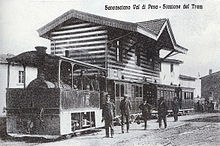
The first mechanical trams were powered by steam. Generally, there were two types of steam tram. The first and most common had a small steam locomotive (called a tram engine in the UK) at the head of a line of one or more carriages, similar to a small train. Systems with such steam trams included Christchurch, New Zealand; Sydney, Australia; other city systems in New South Wales; Munich, Germany (from August 1883 on) and the Dublin & Blessington Steam Tramway in Ireland. Steam tramways also were used on the suburban tramway lines around Milan; the last Gamba de Legn ("Peg-Leg") tramway ran on the Milan- Magenta-Castano Primo route in late 1958.
Tram engines usually had modifications to make them suitable for street running in residential areas. The wheels, and other moving parts of the machinery, were usually enclosed for safety reasons and to make the engines quieter. Measures were often taken to prevent the engines from emitting visible smoke or steam. Usually the engines used coke rather than coal as fuel to avoid emitting smoke; condensers or superheating were used to avoid emitting visible steam.
The other style of steam tram had the steam engine in the body of the tram, referred to as a tram engine or steam dummy. The most notable system to adopt such trams was in Paris. French-designed steam trams also operated in Rockhampton, in the Australian state of Queensland between 1909 and 1939. Stockholm, Sweden, had a steam tram line at the island of Södermalm between 1887 and 1901. A major drawback of this style of tram was the limited space for the engine, so that these trams were usually underpowered.
Cable-hauled
The next motive system for trams was the cable car, which was pulled along a fixed track by a moving steel cable. The power to move the cable was normally provided at a "powerhouse" site a distance away from the actual vehicle.
The first practical cable car line was tested in San Francisco, in 1873. Part of its success is attributed to the development of an effective and reliable cable grip mechanism, to grab and release the moving cable without damage. The second city to operate cable trams was Dunedin in New Zealand, from 1881 to 1957. From 1885 to 1940, the city of Melbourne, Victoria, Australia operated one of the largest cable systems in the world, at its peak running 592 trams on 75 kilometres (47 mi) of track. There were also two isolated cable lines in Sydney, New South Wales, Australia.
New York City developed at least seven cable car lines. A line in Washington DC ran to Georgetown (where some of the underground cable vaults can still be seen today). Los Angeles also had several cable car lines, including the Second Street Cable Railroad, which operated from 1885 to 1889, and the Temple Street Cable Railway, which operated from 1886 to 1898. The most extensive cable system in the US was in Chicago.
In Dresden, Germany, in 1901 an elevated suspended cable car following the Eugen Langen one-railed floating tram system started operating. Cable cars operated on Highgate Hill in North London and Kennington to Brixton Hill In South London. They also worked around "Upper Douglas" in the Isle of Man (cable car 72/73 is the sole survivor of the fleet).
Cable cars suffered from high infrastructure costs, since an expensive system of cables, pulleys, stationary engines and lengthy underground vault structures beneath the rails had to be provided. They also required physical strength and skill to operate, and alert operators to avoid obstructions and other cable cars. The cable had to be disconnected ("dropped") at designated locations to allow the cars to coast by momentum, for example when crossing another cable line. The cable would then have to be "picked up" to resume progress, the whole operation requiring precise timing to avoid damage to the cable and the grip mechanism.
Breaks and frays in the cable, which occurred frequently, required the complete cessation of services over a cable route while the cable was repaired. Due to overall wear, the entire length of cable (typically several kilometres) would have to be replaced on a regular schedule. After the development of reliable electrically powered trams, the costly high-maintenance cable car systems were rapidly replaced in most locations.
Cable cars remained especially effective in hilly cities, since their nondriven wheels would not lose traction as they climbed or descended a steep hill. The moving cable would physically pull the car up the hill at a steady pace, unlike a low-powered steam or horse-drawn car. Cable cars do have wheel brakes and track brakes, but the cable also helps restrain the car to going downhill at a constant speed. Performance in steep terrain partially explains the survival of cable cars in San Francisco. However, the extensive cable car system of Chicago operated over a large relatively flat area.
The San Francisco cable cars, though significantly reduced in number, continue to perform a regular transportation function, in addition to being a well-known tourist attraction. A single cable line also survives in Wellington, New Zealand (rebuilt in 1979 as a funicular but still called the " Wellington Cable Car").
Hybrid funicular electric
The Opicina Tramway in Trieste operates a hybrid funicular electric system. Conventional electric trams are operated in street running and on reserved track for most of their route. However, on one steep segment of track, they are assisted by cable tractors, which push the trams uphill and act as brakes for the downhill run. For safety, the cable tractors are always deployed on the downhill side of the tram vehicle.
Electric (trolley cars)
Electric trams (known as streetcars or trolleys in North America) were first experimentally installed in Saint Petersburg, Russia, invented and tested by Fyodor Pirotsky as early as 1880. These trams, like virtually all others mentioned in this section, used either a trolley pole or a pantograph, to feed power from electric wires strung above the tram route. Nevertheless, there were early experiments with battery-powered trams but these appear to have all been unsuccessful. The first trams in Bendigo, Australia, in 1892, were battery-powered but within as little as three months they were replaced with horse-drawn trams. In New York City some minor lines also used storage batteries. Then, comparatively recently, during the 1950s, a longer battery-operated tramway line ran from Milan to Bergamo.
The first regular electric tram service using pantographs or trolley poles, the Gross-Lichterfelde Tramway, went into service in Lichterfelde, a suburb of Berlin, Germany, by Siemens & Halske AG, in May 1881. The company Siemens still exists.
Another was by John Joseph Wright, brother of the famous mining entrepreneur Whitaker Wright, in Toronto in 1883. Earlier installations proved difficult or unreliable. Siemens' line, for example, provided power through a live rail and a return rail, like a model train, limiting the voltage that could be used, and providing electric shocks to people and animals crossing the tracks. Siemens later designed his own method of current collection, from an overhead wire, called the bow collector.
In 1883, Magnus Volk constructed his 2 feet (610 mm) gauge Volk's Electric Railway along the eastern seafront at Brighton, England. This two kilometer line, re-gauged to 2 feet 9 inches (840 mm) in 1884, remains in service to this day, and is the oldest operating electric tramway in the world. The first tram for permanent service with overhead lines was the Mödling and Hinterbrühl Tram in Austria. It began operating in October 1883, but was closed in 1932.
Multiple functioning experimental electric trams were exhibited at the 1884 World Cotton Centennial World's Fair in New Orleans, Louisiana, but they were not deemed good enough to replace the Lamm fireless engines that then propelled the St. Charles Avenue Streetcar in that city.
Electric trams were first tested in service in the United States in Richmond, Virginia, in 1888, in the Richmond Union Passenger Railway built by Frank J. Sprague, though the first commercial installation of an electric streetcar in the United States was built in 1884 in Cleveland, Ohio and operated for a period of one year by the East Cleveland Street Railway Company.
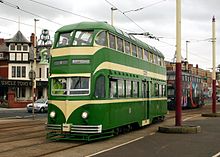
The first electric street tramway in Britain, the Blackpool Tramway, was opened on 29 September 1885 using conduit collection along Blackpool Promenade. Since the closure of the Glasgow Corporation Tramways in 1962, this has been the only first-generation operational tramway in the UK.
Sarajevo had the first electric trams on the continent of Europe, with a city-wide system in 1885. Budapest established its tramway system in 1887, and this line has grown to be the busiest tram line in Europe, with a tram running every 60 seconds at rush hour (however Istanbul's line T1, with a minimum headway of two minutes, probably carries more passengers – 265,000 per day). Bucharest and Belgrade ran a regular service from 1894. Ljubljana introduced its tram system in 1901 – it closed in 1958.
In Australia there were electric systems in Sydney, Newcastle, Broken Hill, Geelong, Ballarat, Bendigo, Brisbane, Adelaide, Perth, Kalgoorlie, Laverton, Hobart and Launceston. By the 1970s, the only tramway system remaining in Australia was the extensive Melbourne system other than a few single lines remaining elsewhere: the Glenelg Tram, connecting Adelaide to the beachside suburb of Glenelg, and tourist trams in the Victorian Goldfields cities of Bendigo and Ballarat. An unusual line that operated from 1889 to 1896 connected Box Hill, then an outer suburb of Melbourne, to Doncaster, then a favoured picnic spot but now a dormitory suburb. In recent years the Melbourne system, generally recognised as one of the largest in the world, has been considerably moderrnised and expanded. The Adelaide line has also been extended to the Entertainment Centre, and there are plans to expand further.
In 1904 trams were put into operation in Hong Kong. The Hong Kong Tramway is still in operation today and uses double-decker trams exclusively.
Gas trams
In the late 19th and early 20th centuries a number of systems in various parts of the world employed trams powered by gas, naphtha gas or coal gas in particular. Gas trams are known to have operated between Alphington and Clifton Hill in the northern suburbs of Melbourne, Australia (1886–1888); in Berlin and Dresden, Germany; in Estonia (1920s–1930); between Jelenia Góra, Cieplice, and Sobieszów in Poland (from 1897); and in the UK at Lytham St Annes, Neath (1896–1920), and Trafford Park, Manchester (1897–1908).
On 29 December 1886 the Melburnian newspaper The Argus reprinted a report from the San Francisco Bulletin that Mr Noble had demonstrated a new ‘motor car’ for tramways 'with success'. The tramcar ‘exactly similar in size, shape, and capacity to a cable grip car’ had the ‘motive power’ of gas ‘with which the reservoir is to be charged once a day at power stations by means of a rubber hose’. The car also carried an electricity generator for ‘lighting up the tram and also for driving the engine on steep grades and effecting a start’.
Comparatively little has been published about gas trams. However, research on the subject was carried out for an article in the October 2011 edition of "The Times", the historical journal of the Australian Association of Timetable Collectors.
A tram system powered by compressed gas was due to open in Malaysia in 2012, but as at January 2013 there was no evidence of anything having happpened, in fact news about the project appeared to have dried up.
Design
Low floor
The latest generation of light rail vehicles is of partial or fully low-floor design, with the floor 300 to 360 mm (11.8 to 14.2 in) above top of rail, a capability not found in older vehicles. This allows them to load passengers, including those in wheelchairs, directly from low-rise platforms that are not much more than raised footpaths/sidewalks. This satisfies requirements to provide access to disabled passengers without using expensive wheelchair lifts, while at the same time making boarding faster and easier for other passengers.
Various companies have developed particular low-floor designs, varying from part-low-floor (with internal steps between the low-floor section and the high-floor sections over the bogies), e.g. Citytram and Siemens S70, to 100% low-floor, where the floor passes through a corridor between the drive wheels, thus maintaining a relatively constant (stepless) level from end to end of the tram.
Prior to the introduction of the Škoda ForCity, this carried the mechanical penalty of requiring bogies to be fixed and unable to pivot (except for less than 5 degrees in some trams) and thus reducing curve negotiation. This creates undue wear on the tracks and wheels.
Passengers appreciate the ease of boarding and alighting from low-floor trams and moving about inside 100% low-floor trams. Passenger satisfaction with low-floor trams is high.
Low-floor trams are now running in many cities around the world, including Amsterdam, Dublin, Hiroshima, Houston, Istanbul, Melbourne, Milan, Prague, Riga, Strasbourg, Vienna, Zagreb, Helsinki and Zürich.
Ultra low floor
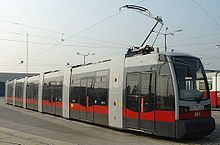
The Ultra Low Floor or (ULF) tram is a type of low-floor tram operating in Vienna, Austria and Oradea, Romania, with the lowest floor-height of any such vehicle. In contrast to other low-floor trams, the floor in the interior of ULF is at sidewalk height (about 18 cm or 7 inches above the road surface), which makes access to trams easy for passengers in wheelchairs or with baby carriages. This configuration required a new undercarriage. The axles had to be replaced by a complicated electronic steering of the traction motors. Auxiliary devices are installed largely under the car’s roof.
Articulated

Articulated trams, invented and first used by the Boston Elevated Railway in 1912–13 at a total length of about twelve meters long (40 ft) for each pioneering example of twin-section articulated tram car, have two or more body sections, connected by flexible joints and a round platform at their pivoting midsection(s). Like articulated buses, they have increased passenger capacity. In practice, these trams can be up to 53 metres (174 ft) long (such as in Budapest, Hungary), while a regular tram has to be much shorter. With this type, the articulation is normally suspended between carbody sections.
In the Škoda ForCity, which is the world's first 100% low floor tram with pivoting bogies, a Jacobs bogie supports the articulation between the two or more carbody sections. An articulated tram may be low-floor variety or high (regular) floor variety. Newer model trams may be up to 72 metres (236 ft) long and carry 510 passengers at a comfortable 4 passengers/m2. At crush loadings this would be even higher.
Double decker
Double decker trams were commonplace in Great Britain and Dublin Ireland before most tramways were torn up in the 1950s and 1960s.
Hobart, Tasmania, Australia made extensive use of double decker trams. Arguably the most unusual double decker tram used to run between the isolated Western Australian outback village of Laverton and its small suburb of Gwalia.
Double decker trams still operate in Alexandria, Blackpool and Hong Kong.
Tram-train
Tram-train operation uses vehicles such as the Flexity Link and Regio- Citadis, which are suited for use on urban tram lines and also meet the necessary indication, power, and strength requirements for operation on main-line railways. This allows passengers to travel from suburban areas into city-centre destinations without having to change from a train to a tram.
It has been primarily developed in Germanic countries, in particular Germany and Switzerland. Karlsruhe is a notable pioneer of the tram-train.
Non-commuter
Cargo trams
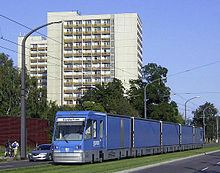
Since the 19th century goods have been carried on rail vehicles through the streets, often near docks and steelworks, for example the Weymouth Harbour Tramway in Weymouth, Dorset. Belgian vicinal tramway routes were used to haul timber and coal from Blégny colliery while in the USA several of the US interurbans carried freight. In Australia, three different "Freight Cars" operated in Melbourne between 1927 and 1977 and the city of Kislovodsk in Russia had a freight-only tram system consisting of one line which was used exclusively to deliver bottled Narzan mineral water to the railway station.
Today, the German city of Dresden has a regular CarGoTram service, run by the world's longest tram trainsets (59.4 metres (195 ft)), carrying car parts across the city centre to its Volkswagen factory. In addition to Dresden, the cities of Vienna and Zürich currently use trams as mobile recycling depots.
At the turn of the 21st century, a new interest has arisen in using urban tramway systems to transport goods. The motivation now is to reduce air pollution, traffic congestion and damage to road surfaces in city centres.
One recent proposal to bring cargo tramways back into wider use was the plan by City Cargo Amsterdam to reintroduce them into the city of Amsterdam. In the spring of 2007 the city piloted this cargo tram operation, which among its aims aimed to reduce particulate pollution in the city by 20% by halving the number of lorries (5,000) unloading in the inner city during the permitted timeframe from 07:00 till 10:30. The pilot involved two cargo trams, operating from a distribution centre and delivering to a "hub" where special electric trucks delivered the trams' small containers to their final destination. The trial was successful, releasing an intended investment of €100 million in a fleet of 52 cargo trams distributing from four peripheral "cross docks" to 15 inner-city hubs by 2012. These specially built vehicles would be 30 feet (9.14 m) long with 12 axles and a payload of 30 tonnes (33.1 short tons; 29.5 long tons). On weekdays, trams are planned to make 4 deliveries per hour between 7 a.m. and 11 a.m. and two per hour between 11 a.m. and 11 p.m. With each unloading operation taking on average 10 minutes, this means that each site would be active for 40 minutes out of each hour during the morning rush hour. In early 2009 the scheme was suspended owing to the financial crisis impeding fund-raising.
Hearse-tram
Specially appointed hearse trams were used for funerals in Milan, Italy, from the 1880s (initially horse-drawn) to the 1920s. The main cemeteries, Cimitero Monumentale and Cimitero Maggiore, included funeral tram stations. Additional funeral stations were located at Piazza Firenze and at Porta Romana.
In the mid-1940s at least one special hearse tram was used in Turin, Italy. It was introduced due to the wartime shortage of automotive fuel.
Newcastle, NSW, Australia also operated two hearse trams between 1896 and 1948.
Dog car
In Melbourne a "dog car" was used between 1937 and 1955 for transporting dogs and their owners to the Royal Melbourne Showgrounds.
Contractors' mobile offices
Two former passenger cars from the Melbourne system were converted and used as mobile offices within the Preston Workshops between 1969 and 1974, by personnel from Commonwealth Engineering and ASEA who were connected with the construction of Melbourne's Z Class cars.
Restaurant trams
A number of systems have introduced restaurant trams, particularly as a tourist attraction. This is specifically a modern trend. Inter alia, tram systems which have or have had restaurant trams include: Adelaide, Australia; Bendigo, Australia; Brussels, Belgium, Christchurch, New Zealand, (currently suspended pending post earthquake infrastructure assessment); Melbourne, Australia; Milan, Italy; Moscow, Russia; Turin, Italy; Zürich, Switzerland.
These type of vehicles are particularly popular in Melbourne where three of the iconic "W" class trams have been converted to restaurant trams. All three often run in tandem and there are usually different sittings for meals. Bookings often close months in advance.
Bistro trams with buffets operate between Krefeld and Düsseldorf in Germany, while Helsinki in Finland has a pub tram. Frankfurt, Germany has a tourist circle line called "Ebbelwei-Express", in which the traditional local drink "Apfelwein" is served.
Mobile Libary Service in Munich
Somekind famous, a Munich Tram, Number 24, delivered 1912, was refurnished to a mobile library in 1928 and used as "Städtischen Wanderbücherei München" in public library service for about 40 years till 1970. The library car and train was preserved and is nowadays on public display in a railway museum in Hannover. Maybe one-of-a-kind, as it isn't known if there is or was another train or, as here, tram library worldwide.
Nursery tramway in Warsaw
After World War Two, in both Warsaw and Wrocław, Poland, so-called tramways-nurseries were in operation, collecting children from the workplaces of their parents (often tram employees). These mobile nursuries either carried the children around the system or delivered them to the nursery school run by transport company.
Work Trains and others
Most systems had cars that were converted to specific uses on the system, other than simply the carriage of passengers. As just one example, the Melbourne system used or uses the following "technical" cars : a Ballast Motor, Ballast Trailers, a Blow Car, Breakdown Cars, Conductors and/or Drivers' Instruction Cars, a Laboratory Testing Car, a Line Marking Car, a Pantograph Testing Car, Per Way Locomotives, Rail Grinders, a Rail Hardner Loco., a Scrapper Car, Scrubbers, Sleeper Carriers, Track Cleaners, a Welding Car, a Wheel Transport Car and a Workshops Locomotive.
Advertising
Many systems have passenger carrying vehicles with all-over advertising on the exterior and/or the interior. Toy Trains are delivered for collectors and children, or delivered and build by themselves out of cardboard.
Tramway operation
There are two main types of Tramways, the classic tramway build in the early 20th century with the tram system operating in mixed traffic and the later type which is most often associated with the tram system having its own right of way. Tram systems that have their own right of way are often called Light Rail but this does not always hold true. Though these two systems differ in their operation their equipment is much the same.
- Infrastructure and equipment
- Tram stop
- Controls
- Track
- Power supply
- Ground-level power supply
- Conduit current collection
Tram and light-rail transit systems around the world
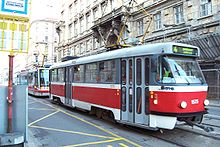
Throughout the world there are many tram systems; some dating from the late 19th or early 20th centuries. However a large number of the old systems were closed during the mid-20th century because of such perceived drawbacks as route inflexibility and maintenance expense. This was especially the case in North American, British, French and other West European cities. Some traditional tram systems did however survive and remain operating much as when first built over a century ago. In the past twenty years their numbers have been augmented by modern tramway or light rail systems in cities that had discarded this form of transport.
Popularity
Tramways with tramcars ( British English) or street railways with streetcars (American English) were common throughout the industrialised world in the late 19th and early 20th centuries but they had disappeared from most British, Canadian, French and US cities by the mid-20th century.
By contrast, trams in parts of continental Europe continued to be used by many cities, although there were contractions in some countries, including the Netherlands.
Since 1980 trams have returned to favour in many places, partly because their tendency to dominate the roadway, formerly seen as a disadvantage, is now considered to be a merit. New systems have been built in the United States, Great Britain, Ireland, France and many other countries.
In Milan, Italy, the old " Ventotto" trams are considered by its inhabitants a "symbol" of the city.
Largest tram systems
The five largest tram networks in the world by track length are; Melbourne, Australia (250 km (160 mi)), St. Petersburg (240 km (150 mi)), Berlin (190 km (120 mi)), Moscow (181 km (112 mi)) and Vienna (172 km (107 mi)). The longest single tram line in the world is the Belgian Coast Tram, which runs almost the entire length of the Belgian coast. Other large systems include (but not limited to), Amsterdam, Brussels, Bucharest, Budapest, Kiev, Leipzig, Milan, Prague, the Silesian Interurbans, Toronto, Turin, Warsaw, Zagreb and Zurich.
Before its decline the BVG in Berlin operated a very large network with 634 km of route. The largest tram system ever with 857 km existed in Buenos Aires before the 1960s. During a period in the 1980s the world's largest tram system was in Leningrad, USSR, being included in Guinness World Records.
Until the system started to be converted to trolleybus (and later bus) in the 1930s, the first-generation London network was also one of the world's largest, with 526 km (327 mi) of route in 1934. While the largest streetcar network in the world used to be located in Chicago, with over 850 kilometres (530 mi) of track, all of it was converted to bus service by the late 1950s.
Asia
Tramway systems were well established in the Asian region at the start of the 20th century, but started a steady decline during the mid to late 1930s. The 1960s marked the end of its dominance in public transportation with most major systems closed and the equipment and rails sold for scrap; however, some extensive original lines still remain in service in Hong Kong and Japan. In recent years there has been renewed interest in the tram with modern systems being built in Japan, the Philippines, and South Korea.
Trams still operate in Calcutta, India. Trams were discontinued in Bombay, India in 1960. There were Trolley Buses also in Bombay (now called Mumbai), the last of which operated between Mazagon and Grant Road, which was discontinued in the late 1970s.
The Northern and Central areas of the City of Colombo in SriLanka had an electric Tram Car system (42" Gauge). This system commenced operations about 1900 and was discontinued by 1960. The original operator was the Colombo Electric Tram Car and Lighting Company Ltd. (represented by Boustead Brothers), and after an infamous Tram Car Strike, the Colombo Municipal Council took over operations. Subsequently, the tram car system was phased out.
Other countries with discontinued tram systems include Malaysia, Thailand, Pakistan and Vietnam. However, a tram system is planned for construction in Gwadar, Pakistan where construction started in late 2011. In China the cities of Beijing, Zhuhai, Nanjing and Shenzhen are planning tram networks for the future.
The first Japanese tram line was inaugurated in 1895 as the Kyoto Electric Railroad. The tram reached its zenith in 1932 when 82 rail companies operated 1,479 kilometers of track in 65 cities. The tram declined in popularity through the remaining years of the 1930s, a trend that was accelerated by the damage of the War and continued through the Occupation and rebuilding years. During the 1960s many of the remaining operational tramways were shut down and dismantled in favour of auto, bus, and rapid rail service; however, when one compares the number of operational lines that survived this era to their American counterparts, they can be defined as quite extensive.
Europe
In many European cities much tramway infrastructure was lost in the mid-20th century, though not always on the same scale as in other parts of the world such as North America. Most of Eastern Europe retained tramway systems until recent years but some cities are now reconsidering their transport priorities. In contrast, some Western European cities are rehabilitating, upgrading, expanding and reconstructing their old tramway lines. Many Western European towns and cities are also building new tramway lines.
North America
In North America, trams are generally known as "streetcars" (or sometimes as "trolleys"); the term tram is more likely to be understood as a tourist trolley, an aerial tramway, or a people-mover.
In most North American cities, streetcar lines were largely torn up in the mid-20th century for a variety of financial, technological and social reasons, mainly as a result of the Great American Streetcar Scandal. Exceptions included Boston, New Orleans, Newark, Philadelphia (with a much shrunken network), Pittsburgh, San Francisco, Cleveland, and Toronto. Pittsburgh had kept most of its streetcar system serving the city and many suburbs until severe cutbacks on 27 January 1967, making it the longest-lasting large-network US streetcar system.
In a trend started in the 1980s, some American cities have brought back streetcars, examples of these being Memphis, Portland, Tampa, Little Rock, Seattle and San Diego.
Portland revived its streetcar system in 1986. More recently, Portland received over $23 million in federal funding to enhance transportation connections throughout this Oregon city. Overall, the streetcar project costs were over $148 million, and a new 3.3-mile route was the most expensive streetcar expansion in US history. Oregon Iron Works, the only US company currently producing a modern streetcar, holds a contract valued at over $19 million with the city of Portland. The project is behind schedule, as only one of the five streetcars has been delivered.
Several additional cities, such as Washington DC, Tucson, Detroit and Sacramento are planning or proposing new streetcar systems.
In the late 20th century, several cities installed light rail systems, in part along the same corridors as the old streetcars.
Toronto currently has the largest streetcar system in the Americas in terms of track length and ridership, operated by the Toronto Transit Commission. This is the only large-scale streetcar system existing in Canada, not including the light rail systems that some Canadian cities currently operate, or heritage streetcar lines operating only seasonally. Toronto's system uses Canadian Light Rail Vehicles and Articulated Light Rail Vehicles, after a history of using PCCs, Peter Witt cars, and horse-drawn carriages. The TTC has ordered a fleet of Bombardier's Flexity Outlook (also used in some European tram systems) as a replacement, and is in acceptance testing as of Fall 2012.
Streetcars once existed in Edmonton and Calgary, but both Canadian cities have since converted their systems to support light rail vehicles instead. Streetcars also once existed in Ottawa, Montreal, Kitchener, Hamilton, Kingston and Peterborough. Some of these cities have restored their old streetcars and run them as a heritage feature for tourists, such as the Vancouver Downtown Historic Railway.
Oceania
In Australia, trams are used extensively only in Melbourne, and to a lesser extent, Adelaide, all other major cities having largely dismantled their networks by the 1970s. Sydney reintroduced its tram in 1997 as a modern system ( Metro Light Rail), while Ballarat reintroduced their trams as a heritage system. Bendigo had a heritage system for a while which has recently been upgraded to a simple public transport system through an increase in frequency.
A distinctive feature of many Australian trams was the early use of a lowered central section between bogies (wheel-sets). This was intended to make passenger access easier, by reducing the number of steps required to reach the inside of the vehicle. It is believed that the design first originated in Christchurch, New Zealand, in the first decade of the 20th century. Cars with this design feature were frequently referred to as "drop-centres". Trams for Christchurch and Wellington built in the 1920s with an enclosed section at each end and an open-sided middle section were also known as boon cars, but did not have the drop-centre. Trams built since the 1970s have had conventional high or low floors.
New Zealand's last public transport tramway system, that of Wellington, closed in 1966. Christchurch however subsequently reintroduced heritage trams over a new CBD route, but the overhead wiring plus some track was damaged by the earthquake of 2011 and reintroduction of the system is currently tied into the debates about what form the city should take in the future. Auckland has recently introduced heritage trams into the Wynyard area, near the CBD using former Melbourne trams as no operable former Auckland cars are believed to exist. A heritage line exists in Queen Elizabeth Park on the Kapiti Coast, running through open countryside.
South America
Buenos Aires in Argentina had once one of the most extensive tramway networks in the world with over 857 km (535 mi) of track, most of it dismantled during the 1960s in favour of bus transportation. Now slowly coming back, the 2 km Puerto Madero Tramway running in the Puerto Madero district is spearheading the move with extensions to Retiro station and La Boca in the planning stages. Another line, the PreMetro line E2 system feeding the Line E of the Buenos Aires Subway has been operating for the past few years on the outskirts of Buenos Aires, and a unique leisure " Tren de la Costa", an artery that stretches for 15 kilometres by the River Plate, from Olivos to the village of Tigre has also been running in Buenos Aires.
Also in the city Mendoza, in Argentina, a new tramway system is in construction, the Metrotranvía of Mendoza, which will have a route of 12.5 km and will link five districts of the Greater Mendoza conurbation. The opening of the system is scheduled for August 2011.
In Medellín, Colombia, there is a tram line under construction and the opening schedule is for December 2011. Bogota, Colombia used to have a very extensive tram system until the violent events of the Bogotazo in 1948.
Pros and cons of tram systems
All transit services, except personal rapid transit, involve a trade-off between speed and frequency of stops. Services that stop frequently have a lower overall speed, and are therefore less attractive for longer trips. Metros, light rail, monorail, and bus rapid transit are all forms of rapid transit, which generally signifies high speed and widely spaced stops. Trams are often used as a form of local transit, making frequent stops. Thus, the most meaningful comparison of advantages and disadvantages is with other forms of local transit, primarily the local bus.
Advantages
- Steel wheels on steel track create about one-seventh as much friction as rubber tyres on bitumen, thus creating dramatically less pollution when carrying the same load.
- Unlike omnibuses, but like trolleybuses, (electric) trams give off no exhaust emissions at point of use.
- Most trams can be driven from either end (the major exception being the PCC car used in North America). This means that the infrastructure needed at termini can be quite simple. In comparison, trolleybuses usually require loops that take up much space, and omnibuses often travel over a circular route at termini thus doing damage to more roads, as well as being confusing to potential passengers.
- Compared to motorbuses the noise of trams is generally perceived to be less disturbing. However, the use of solid axles with wheels fixed to them causes slippage between wheels and tracks when negotiating curves. This produces a characteristic squeal.
- They can use overhead wire set to be shared with trolleybuses (a three wire system).
- The existence of a fixed route gives people confidence in the robustness and long-term future of the system, allowing them to rely on it and build their lifestyles around it. A bus route could be cancelled at any time, but a tram line is far less likely to close down.
- Some trams can adapt to the number of passengers by adding more cars during rush hour (and removing them during off-peak hours). No additional driver is then required for the trip in comparison to buses.
- In general, trams provide a higher capacity service than buses.
- Multiple entrances allow trams to load faster than suburban coaches, which tend to have a single entrance. This, combined with swifter acceleration and braking, lets trams maintain higher overall speeds than buses, if congestion allows.
- The trams' stops in the street are easily accessible, unlike stations of subways and commuter railways placed underground (with several escalators, stairways etc.) or in the outskirts of the city centre.
- Rights-of-way for trams are narrower than for buses. This saves valuable space in cities with high population densities and/or narrow streets.
- Trams can trackshare with mainline railways, servicing smaller towns without requiring special track as in Stadtbahn Karlsruhe and at greater speed than buses.
- Passenger comfort is normally superior to buses because of controlled acceleration and braking and curve easement. Rail transport such as used by trams provides a smoother ride than road use by buses.
- Because the tracks are visible, it is easy for potential riders to know where the routes are.
- Because trams run on rails, the ride is far more comfortable than that of a rubber-tyred bus. Blemishes in the road surface are far less noticeable.
- Vehicles run more efficiently and overall operating costs are lower.
- Trams can run on renewable electricity without the need for very expensive and short life batteries.
- Consistent market research and experience over the last 50 years in Europe and North America shows that car commuters are willing to transfer some trips to rail-based public transport but not to buses. Typically light rail systems attract between 30 and 40% of their patronage from former car trips. Rapid transit bus systems attract less than 5% of trips from cars, less than the variability of traffic.
Disadvantages
- Tram infrastructure (such as island platforms) occupies urban space at ground-level, sometimes to the exclusion of other users.
- The capital cost is higher than for buses, even though a tramcar usually has a much longer lifetime than a bus.
- One study concluded that it would cost less to buy new fuel efficient cars for the low income riders of light rail who do not have cars than it does to subsidize light rail. However, others assert the study was "poorly researched and analytically deficient" or otherwise deficient.
- Trams can cause speed reduction for other transport modes (buses, cars) when stops in the middle of the road do not have pedestrian refuges, as in such configurations other traffic cannot pass whilst passengers alight or board the tram.
- When operated in mixed traffic, trams are more likely to be delayed by disruptions in their lane. Buses, by contrast, can sometimes manoeuver around obstacles. Opinions differ on whether the deference that drivers show to trams—a cultural issue that varies by country—is sufficient to counteract this disadvantage.
- Tram tracks can be hazardous for cyclists, as bikes, particularly those with narrow tyres, may get their wheels caught in the track grooves. It is possible to close the grooves of the tracks on critical sections by rubber profiles that are pressed down by the wheelflanges of the passing tram but that cannot be lowered by the weight of a cyclist. If not well-maintained, however, these lose their effectiveness over time.
- When wet, tram tracks tend to become slippery and thus dangerous for bicycles and motorcycles, especially in traffic. In some cases, even cars can be affected.
- Steel wheel trams are noisier than rubber-wheeled buses or trolleybuses when cornering if there are no additional measures taken (e.g. greasing wheel flanges, which is standard in new-built systems). In older trams, the wheels are fixed onto axles so they have to rotate together, but going around curves, one wheel or the other has to slip, and that causes loud unpleasant squeals. A related improvement is rubber isolation between the wheel disc and the rim, as used on Boston (Massachusetts, US) Green Line 3400 and 3600 series cars. These cars are much quieter than those with solid metal wheels. (This construction requires a flexible cable to electrically connect the tire to the wheel body.)
- Trams usually have less effective suspension systems than buses, which tends to negate the ride quality benefits of steel rails.
- The opening of new tram and light rail systems has sometimes been accompanied by a marked increase in car accidents, as a result of drivers' unfamiliarity with the physics and geometry of trams. Though such increases may be temporary, long-term conflicts between motorists and light rail operations can be alleviated by segregating their respective rights-of-way and installing appropriate signage and warning systems.
- Rail transport can expose neighbouring populations to moderate levels of low-frequency noise. However, transportation planners use noise mitigation strategies to minimize these effects. Most of all, the potential for decreased private motor vehicle operations along the trolley's service line because of the service provision could result in lower ambient noise levels than without.
- In the event of a breakdown or accident, or even roadworks and maintenance, a whole section of the tram network can be blocked. Buses and trolleybuses can often get past minor blockages, although trolleybuses are restricted by how far they can go from the wires. Conventional buses can divert around major blockages as well, as can most modern trolleybuses that are fitted with auxiliary engines or traction batteries. The tram blockage problem can be mitigated by providing regular crossovers so a tram can run on the opposite line to pass a blockage, although this can be more difficult when running on road sections shared with other road users or when both tracks happen to be blocked. On extensive networks diversionary routes may be available depending on the location of the blockage. Breakdown related problems can be reduced by minimising the situations where a tram would be stuck on route, as well as making it as simple as possible for another tram to rescue a failed one.
- The most nowadays advantage of tram – the other road(secluded paths to avoid traffic), which often cannot be crossed by other vehicles(by law, or physical lacking of the other path) can be achieved nowadays in other ways, sometimes cheaper for the whole new system like ULTra or sometimes just by secluded bus roads, with petrol/gas or electric buses(in this case even some commuters like Paris and BHNS (fr. Bus àHaut Niveau de Service, eng. High Level Service Bus) ordered buses looking similar to new trams, e.g. Solaris Urbino 18 Hybrid MetroStyle).
In popular culture
- Dziga Vertov's experimental 1929 film Man with a Movie Camera includes shots of trams (at 10 and 42 minutes).
- The Rev W. Awdry wrote about GER Class C53 called Toby the Tram Engine, which starred his The Railway Series with his faithful coach, Henrietta.
- A Streetcar Named Desire (play)
- A Streetcar Named Desire (1951 film)
- Black Orpheus (1959), of which the main male character Orfeu is a tram driver in Rio de Janeiro's tram system.
- Toonerville Folks comic strip (1908–55) by Fontaine Fox featuring the "Toonerville Trolley that met all the trains."
- The children's TV show Mister Rogers' Neighbourhood featured a trolley.
- The central plot of the film Who Framed Roger Rabbit involves Judge Doom, the villain, dismantling the streetcars of Los Angeles.
- " The Trolley Song" in the film Meet Me in St. Louis received an Academy Award nomination.
- The 1944 World Series was also known as the "Streetcar Series".
- Malcolm (film), an Australian film about a tram enthusiast who uses his inventions to pull off a bank heist.
- Luis Buñuel filmed La Ilusión viaja en tranvía (English: Illusion Travels by Streetcar) in Mexico in 1953.
- In Akira Kurosawa's film Dodesukaden a mentally ill boy pretends to be a tram conductor.
- The Stompin' Tom Connors song "To It And At It" mentions a man who "can't afford the train, he's sittin' on a streetcar, but he's eastbound just the same."
- The predominance of trams (trolleys) gave rise to the disparaging term trolley dodger for residents of the borough of Brooklyn in New York City. That term, shortened to "Dodger" became the nickname for the Brooklyn Dodgers (now the Los Angeles Dodgers).
- Jens Lekman has a song titled "Tram No. 7 to Heaven", a reference to line 7 of the Gothenburg tram which passes through his native borough of Kortedala.
- The band Beirut has a song titled "Fountains and Tramways" on the EP Pompeii.
- The Elephant Will Never Forget, an 11-minute film made in 1953 by British Transport Films to celebrate the London tram network at the time of the last few days of its operation.
- A W-class tram was used at the opening ceremony of the 2006 Commonwealth Games in Melbourne.
- The Full Monty, set in Sheffield, managed to squeeze a tram passing in the background into three scenes.
- 2009 Thomas Haggerty composed and produced 'Tram' generations 1, 2 and 3 for the popular group TRAM.
- A collaboration between John Ward and Elizabeth Harrod: "a great tram."
- In Chrome Shelled Regios, trams are being used in the Academy City Zuelni.
- Trams feature in the opening credits of the world's longest running TV soap opera Coronation Street, set in a fictional suburb of Greater Manchester. A Blackpool tram killed one of the main characters in 1989 and the most recent faked accident involved a tram (modelled on the Manchester Metrolink) careering off a viaduct into the set in 2009.
In the news
- In the Tottenham Outrage in 1909, two armed robbers hijacked a tram and were chased by the police in another tram.
- On 7 June 1926 Catalan architect Antoni Gaudí was knocked down by a Barcelona tram and subsequently died.
In scale modelling
Model trams are popular in HO scale (1:87) and O scale (1:48 in the US and generally 1:43,5 and 1:45 in Europe and Asia). They are typically powered and will accept plastic figures inside. Common manufacturers are Roco and Lima, with many custom models being made as well. The German firm Hödl and the Austrian Halling specialize in 1:87 scale.
In the US, Bachmann Industries is a mass supplier of HO trams and kits. Bowser Manufacturing has produced white metal models for over 50 years. There are many boutique vendors offering limited run epoxy and wood models. At the high end are highly detailed brass models which are usually imported from Japan or Korea and can cost in excess of $500. Many of these run on 16.5 mm (0.650 in) gauge track, which is correct for the representation of 4 ft 8 1⁄2 in (1,435 mm) (standard gauge) in HO scale as in US and Japan, but incorrect in 4 mm (1:76.2) scale, as it represents 4 ft 8 1⁄2 in (1,435 mm). This scale/gauge hybrid is called OO scale. O scale trams are also very popular among tram modellers because the increased size allows for more detail and easier crafting of overhead wiring. In the US these models are usually purchased in epoxy or wood kits and some as brass models. The Saint Petersburg Tram Company produces highly detailed polyurethane non-powered O Scale models from around the world which can easily be powered by trucks from vendors like Q-Car.
In the US, one of the best resources for model tram enthusiasts is the East Penn Traction Club of Philadelphia.
It is thought that the first example of a working model tramcar in the UK built by an amateur for fun was in 1929, when Frank E. Wilson created a replica of London County Council Tramways E class car 444 in 1:16 scale, which he demonstrated at an early Model Engineer Exhibition. Another of his models was London E/1 1800, which was the only tramway exhibit in the Faraday Memorial Exhibition of 1931. Together with likeminded friends, Frank Wilson went on to found the Tramway & Light Railway Society in 1938, establishing tramway modelling as a hobby.
Types
|
|
|
Regional
|
|
